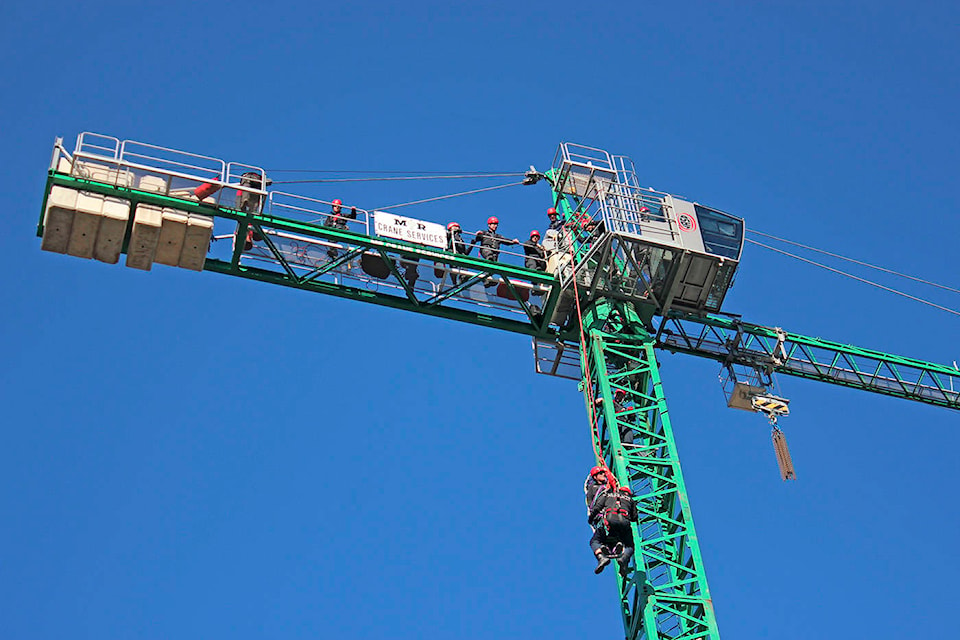When Geoff Spriggs gets the call that a technical team is needed to rescue a person injured or trapped on Mount Finlayson, a dozen questions run through his mind.
Who do we have available to assist on the call? What is the extent of the person’s injuries? Where is that person located exactly? How difficult will the rescue be?
As a commanding officer with a technical team and assistant chief with Langford Fire Rescue when a call comes, Spriggs heads to the scene with the department’s trailer that includes backpacks with ropes, anchoring devices, carabiners, delay devices, harnesses and helmets. Once the team has been assembled, the focus becomes how do they get that injured person down the mountain.
Spriggs is one of several firefighters who are trained to be a part of Langford Fire Rescue’s technical team. While firefighters are used to putting out fires, Spriggs said a technical rescue allows them to use their skills in a more methodical way.
“You get this balance of really hard physical work to really technical, intellectual work to solve the problem,” he said. “You’ve got six different ways you could solve the problem. The intellectual thought that goes in to it is a lot of fun. It really challenges the individuals making those decisions.”
RELATED: Hiker rescued on Mount Finlayson
When it comes to technical rescues, there are several types including high angle rope rescue (if there is a medical emergency on a crane, for example), wilderness rescues, confined spaces rescues and water rescues.
The department receives the highest number of calls related to wilderness rescues, such as if a hiker is injured or lost on Mount Finlayson and are either suffering from a medical emergency or are unprepared for how strenuous the hike can be – and only expect those numbers to climb.
“I’m anticipating with the growth of the city, the growth of our trail systems and the promotion of them as a destination, a place to come and enjoy the trails that the number will increase,” said Spriggs, adding the department is looking at improving the signage in the area and an indication of how difficult a trail is.
RELATED: Emergency crews rescue pregnant woman from Mount Finlayson
During a wilderness rescue, when a person has been found and “packaged” (securing the individual in some way so that they can be moved), depending on the terrain, there is specialty gear used to transport them out.
The first is a sked, which Spriggs describes as a crazy carpet, and allows rescuers to pull the individual through a forest. There is also a B-suit, which is similar to a hammock and is used in a tower crane rescue to safely lower an individual to the ground. A ferno stretcher, also known as a basket stretcher, can be used in an open space.
Other fire departments also specialize in different types of technical rescues as well. Colwood Fire Rescue has a team trained in conducting confined spaces rescues when an individual is unable to get out of a tight space, due to a medical emergency or other hazards such as an oxygen-deficit atmosphere that could cause them to become unconscious.
RELATED: Heading out for a hike on the West Shore? Here’s what you need to be prepared
Capt. Bryan Erwin said the department doesn’t conduct many full confined spaces rescues, but are put on standby should a member of the City’s public works department venture into a sewer pump station or should a Capital Regional District worker venture into a water vault.
“The big difference [between a high angle rope rescue] is equipment. We’re still dealing with ropes and pulleys and mechanical advantage, but a lot of stuff we’ll deal with is lowering and raising people and of course we have to deal with the atmosphere within the hole – testing, ventilating and creating a safe space within the actual confined space itself,” Erwin said.
The Metchosin Fire Department also assists the Langford and Sooke teams with rope rescues and is in the initial stages of completing training for a water rescue team to assist if a car should end up in an embankment in a creek, for example.
“There’s a need for it. If somebody gets in a situation that’s beyond the day-to-day operations of what your training is, you need to have that little extra technical advice and knowledge,” Metchosin Fire Chief Stephanie Dunlop said.
